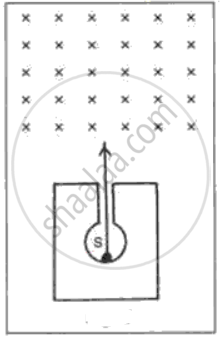Advertisements
Advertisements
Question
An element P disintegrates by α - -emission and the new element suffers two further disintegrations, both by β -emission, to form an element Q. Explain the fact that P and Q are the isotopes.
Solution
The atomic number of P decreases by 2 and mass no. decreases by 4 due to the emission of one alpha particle and then increases by 1 due to the emission of each beta particle, so the atomic number of Q formed after the emission of one alpha and two beta particles is same as that of P. Hence P and Q are the isotopes.
APPEARS IN
RELATED QUESTIONS
How can they be made to leave the metal surface? (State any two ways)
In following fig. shows a mixed source S of alpha and beta particles in a thick lead container. The particles pass through a magnetic field in a direction perpendicular to the plane of paper (inwards as shown by x). State and show in the diagram how the particles get affected.

Radioactive substances were found to give off three types of rays. Name them. How do they
(a) React to the magnetic field?
(b) React to the electric field?
(c) Act when different thickness of lead sheets is placed in their path?
State three safety precautions that you would take while handling the radioactive substances.
What are ‘Becquerel rays’?
State three common properties of beta rays and cathode rays.
Mention one important function of ear main parts:
State the principle on which the functioning of a nuclear reactor is based.
A radioactive nucleus \[\ce{^A_ZX}\] undergoes spontaneous decay in the sequence \[\ce{^A_ZX -> _{Z-1 }B -> _{Z-3}C -> _{Z-2}D }\], where Z is the atomic number of element X. The possible decay particles in the sequence are ______.
The count rate of activity of a radioactive sample of a very large population decreased from 1024 to 128 in 3 minutes. Then the rate of disintegration at the end of 5 minutes is ______.
